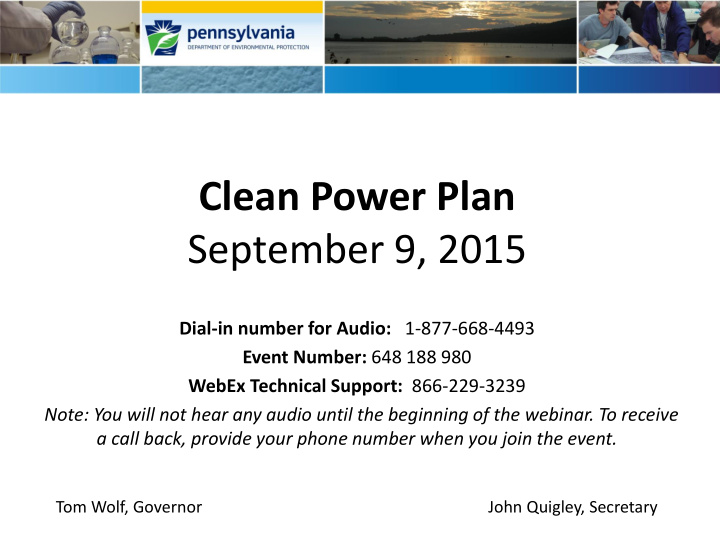



Clean Power Plan September 9, 2015 Dial-in number for Audio: 1-877-668-4493 Event Number: 648 188 980 WebEx Technical Support: 866-229-3239 Note: You will not hear any audio until the beginning of the webinar. To receive a call back, provide your phone number when you join the event. Tom Wolf, Governor John Quigley, Secretary
Complying with Clean Power Plan • U.S. EPA Final Rule covering carbon emissions existing fossil fuel power plants • PA: 33% reduction by 2030 • Compliance obligation begins 2022 • State plan due September 2016 • Or submit draft plan with extension request • Focus on low-income and overburdened communities • DEP committed to a Pennsylvania-centric plan that serves the state’s economy and maintains our net exporter status
Webinar Overview • Overview of Clean Power Plan • Questions that PA needs to address in formulating its plan • Our public participation process • No details on final plan yet – Will use comments received to craft draft plan
Clean Power Plan Basics • EPA rule promulgated under Section 111(d) of the Clean Air Act • EPA establishes emissions guidelines for states • States develop plans according to guidelines and to achieve necessary reductions • If state fails to submit plan or the plan is inadequate, EPA will impose a federal plan
Baseline PA Emissions Using 2012 as the baseline year • Rate: – 1,642 pounds of CO2 per megawatt-hour • Mass: – 117 million tons of CO2 emissions
Calculation of State Targets • Best System for Emissions Reduction (BSER) • U.S. EPA established targets for the state using three “building blocks” – Heat rate improvements – Dispatching more gas over coal – Increased renewable generation • Only used to calculate target, compliance strategies can be farther reaching
CPP Targets for Pennsylvania • 2030 Rate-Based Target: 1,095 pounds per megawatt hour – Interim: 1,258 pounds per megawatt hour • 2030 Mass-Based Target: 90 million tons of emissions – Interim: 99 million tons • “Glide Path” Approach
Rate vs. Mass • Credits vs. Allowances – Credits are self-generating – Allowances are allocated • Key decisions – Allow trading in-state – Enter into multi-state agreements – Common elements approach
Key Considerations • Rate or Mass? • Allocating allowances under mass? • Inclusion of new natural gas plants under mass? • Suggestions on measuring compliance? • Should PA allow out-of-state trading? How?
Key Considerations (cont’d) • Energy efficiency as a compliance option? • Renewables as a compliance option? • Clean Energy Incentive Program? • Least-cost options for compliance? • How can we prioritize indigenous resources? • How can we maintain a diverse fuel mix? • Maintain net exporter status? • Ensure electric reliability?
Key Considerations (cont’d) • Communities experiencing adverse impacts from climate change? • Communities experiencing economic impacts due to the rule? • How can we effectively reach out to vulnerable populations? • Ensure communities are not disproportionately impacted by the state plan?
Comment Period DEP is accepting comment on how PA should approach a state compliance plan – Comments due by November 12, 2015 Comments accepted via: • eComment • Email: ecomment@pa.gov • Mail: PO Box 2063 Harrisburg PA 17105
Listening Sessions
Next Steps • Fall 2015 - Comments received will be used to develop draft plan for Pennsylvania • Spring 2016- Draft plan issued for public comment w/ public hearings • Fall 2016- Submission of final plan to U.S. EPA by September 2016
Conclusion • DEP is seeking comments on how the state should approach its Clean Power Plan submittal • Comments are being accepted through November 12 through eComment • Listening Sessions will be held over the next two months • PA’s goal is to submit a final plan by September 2016
DEP Mission “..is to protect Pennsylvania's air, land and water from pollution and to provide for the health and safety of its citizens through a cleaner environment. We will work as partners with individuals, organizations, governments and businesses to prevent pollution and restore our natural resources.”
Recommend
More recommend